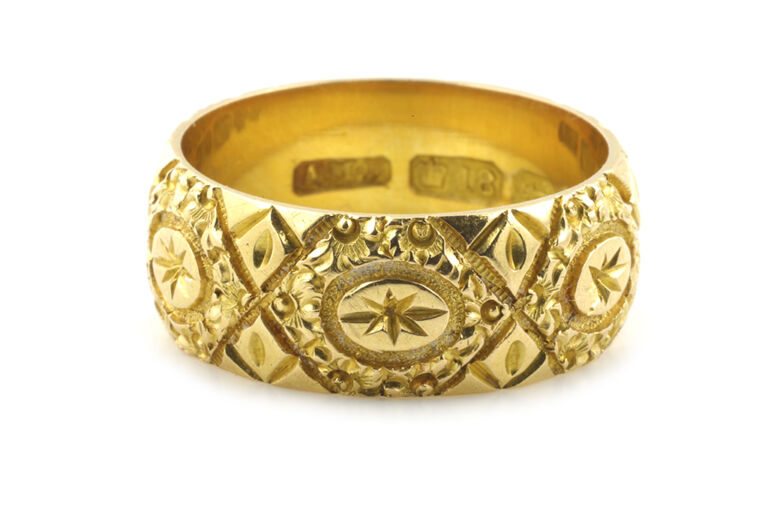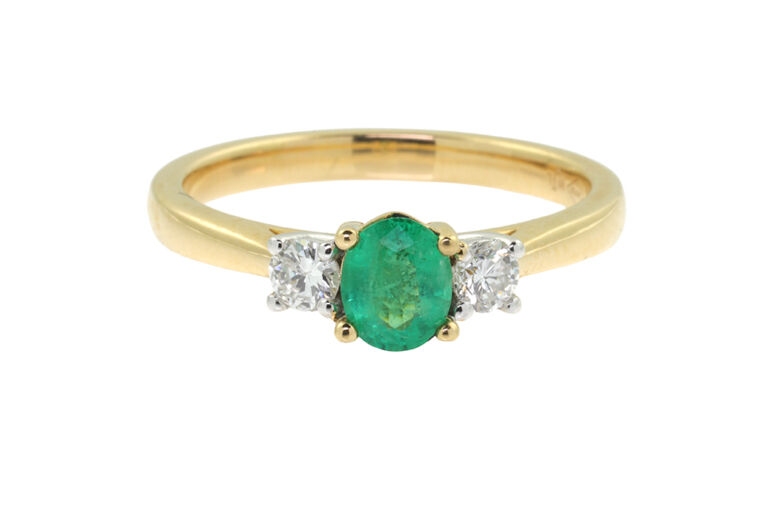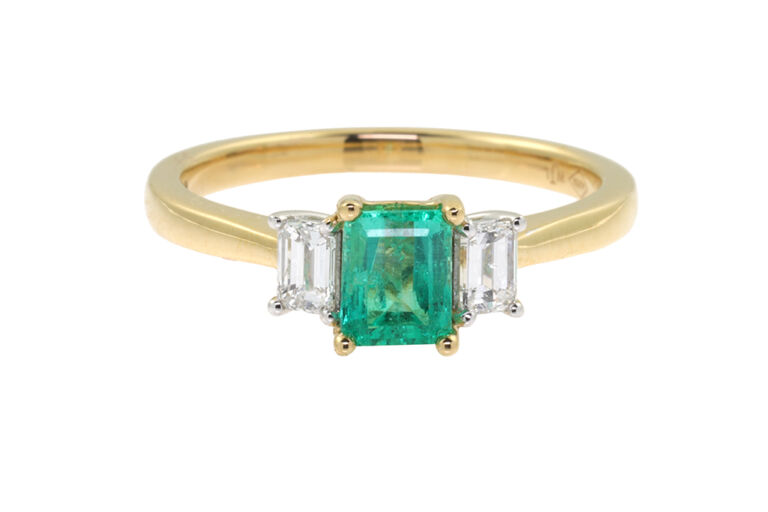

£895.00
Reference: SJ-WEDD-15
18ct yellow gold.
Birmingham hallmark: 1896.
Hand made.
A wide gold ring styled as a ‘keeper’ band, deeply chased with a complex symmetrical combination of six geometric patterns surrounded by naturalistically derived scrollwork.
hese wide band rings appear in profusion in English jewellery of the 1880s and 1890s as part of the fashion for lady’s signet rings. They would initially have been worn on the little finger and are a form of ‘hoop ring’, in that it is a “ring without a bezel” and in this deeply chased form, they earn the additional designation as a keeper or guard ring¹. Several examples of ‘guard rings’ are illustrated in the Mappin & Webb catalogue of 1900.²
The etymology of the term guard ring comes from the late eighteenth and early nineteenth century, with the supposed notion that such a ring could be worn to prevent a more valuable ring worn underneath from slipping off and becoming lost. “But this over-simplifies the question. Guard rings were frequently worn above, not below, stone-set rings, as is demonstrated in a fifteenth-century portrait of a lady by Rogier van der Weyden (c. 1399-1464) [National Gallery, London). The same lady also wears a thin hoop or guard ring by itself on her fourth finger.” ³
These late-nineteenth-century rings eventually served a variety of purposes, such as wedding, keeper, commemorative, mourning, or more generally enjoyed for their decorative qualities.
Additional symbolical use and methods of manufacture are elaborated in the following extract from 1898.
“Keeper Rings are generally given as keepsakes or as tokens of friendship; they are mostly worn by ladies. A ring.. is thus made; — Lengths of flat wire drawn (out) in the metal gauge (according to the weight of the ring required) are cut off and sent to the Assay Office to be Hall-marked. On their return from the office they are carefully turned up with a pair of half-round pliers, or by the improved tool for bending rings, the two ends properly joined and soldered, and the rings boiled out in pickle; they are next shaped on the treblet, filed up into the required form, which process needs great care in setting out, as the outer circumference has to be divided off into a certain number of divisions, to enable a corresponding number of letters to be engraved, chased, enamelled, or soldered on the front. The usual words are the Christian name, or Mizpah, In memory of, or the name of the wearer. The finishing is somewhat different from that of other rings since the panels and edges being perfectly flat they are either gilt or coloured and then lapped by the gold-cutter.” ⁴
Literature.
¹. Rings 1800-1910. A Study of English and Related Designs. Verlaine Davies. 2009. Write Desing Ltd.
². Victorian Jewellery. Peter Hinks. 1991. Studio Editions.
³. Rings. Shirley Bury.1984. HMSO.
⁴. The Art of the Goldsmith and Jeweller: A Treatise on the Manipulation of Gold in the Various Processes of Goldsmith’s Work, and the Manufacture of Personal Ornaments, &c., &c. for the use of Students and Practical Men. By Thomas B. Wigley, 1898, published by C. Griffin and Company, Ltd.

Size U. Spinel weight approximately 1.55cts. Total diamond weight approximately 0.25cts. 18k yellow gold.

Brazilian emerald weight: 0.43cts. Total diamond weight: 0.22cts. 18ct yellow & white gold. Custom made for Studleys Jewellers.

Emerald weight: 0.57cts. Total diamond weight: 0.32cts. 18ct yellow gold. Custom made for Studleys Jewellers.
We are happy to reserve this item for your viewing in our Wells store. Please leave us your details and availability below and let us handle the rest.